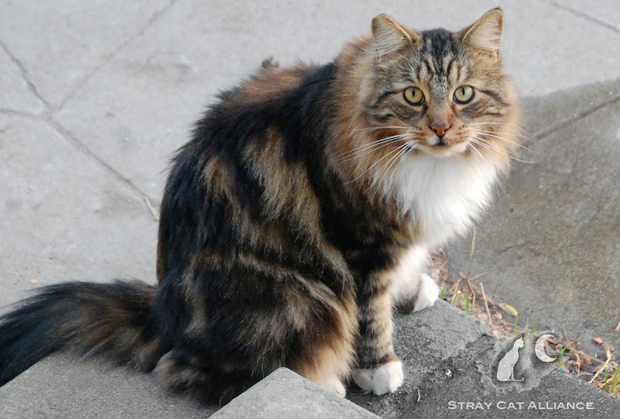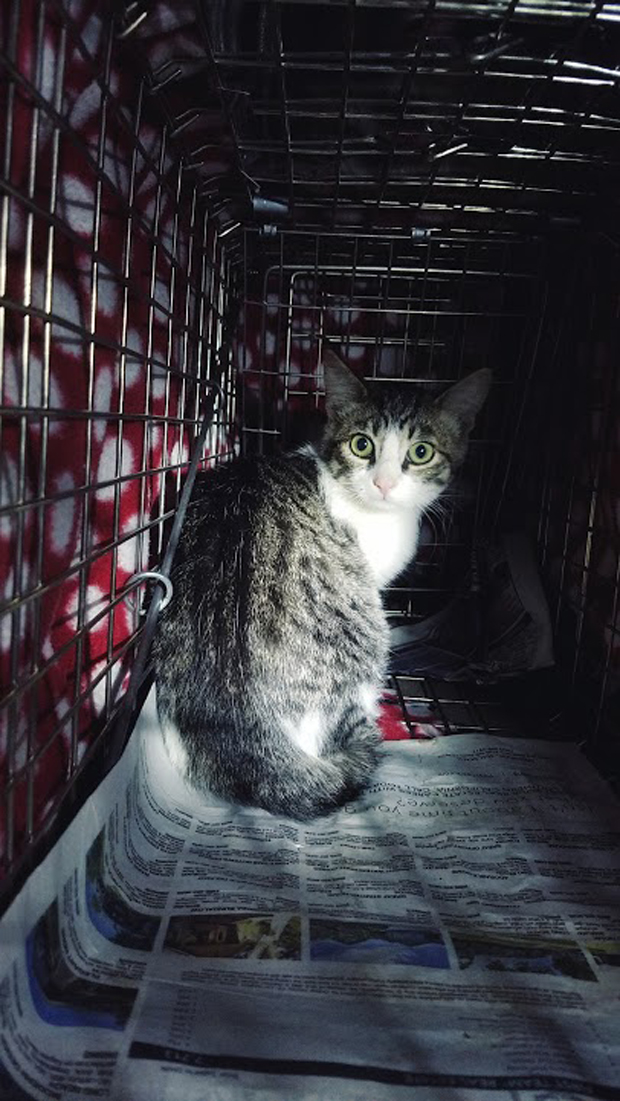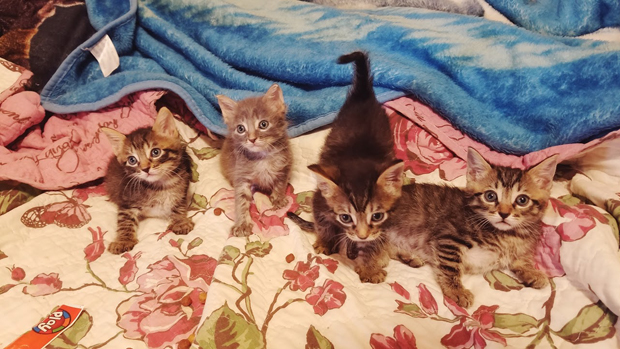
Photos by Jaden Louie, unless otherwise noted.
Kristi Louie and her kids, along with a number of dedicated volunteers, can unarguably teach Knott’s Berry Farm something about quality, wholesome family activity, if not entertainment.
Late one night in early August, Louie and her family were leaving the theme park, referred to on its history timeline as the place for “quality, wholesome family entertainment,” when Louie noticed cats of “various sizes, ages, breeds and temperament” scavenging the trash cans for food. The parking lot, she said, was teeming with cats and young kittens. Her last activity for the evening was to set down plates of dry cat food. Hunger overcame the felines’ fear of humans, and Louie felt pity for their little bodies, all skin and bones.
“It’s what I do,” she said, referring to her family’s act of kindness. “It’s in my blood. I couldn’t turn a blind eye to a cat or a dog or a chicken or a child.”
Louie and one of her daughters are feeders for community cat colonies (groups of stray, feral and abandoned cats) in her home city of Long Beach. She helps maintain the one located on the Long Beach City College grounds and was one of the advocates who spoke up nearly two years ago for continuing its existence at the school. The cats in the colony are healthy and doing fine; she happily noted that the school’s Woodshop class has made an awning to shelter the feeding station from the outside elements.
No such amenities for the Knott’s Berry Farm cats. “Imagine slinking bodies walking out from the shadows toward the trash cans, the picnic tables, and toward any bags of chips or wrappers left on the grounds—to eat,” Louie said.
Louie and her daughters noticed that some of the cats had been ear-tipped. A tipped left ear is the universal sign of a fixed community cat; a small corner of a feral cat’s left ear is removed when the animal is under anesthesia when it’s being altered. The ears led her to believe that there had been a maintained feral colony at one time but that it had been discontinued. She has yet to find out any further information about it.

Cat with tipped left ear. Photo courtesy of Stray Cat Alliance
Louie reached out to Orange County cat-rescue organization Cats in Tow, and Christine Lee, one of their volunteers, met up with Louie to inspect the area and discuss trap/neuter/release (TNR). TNR is a practice that involves humanely trapping cats and taking them to a veterinarian to be examined, neutered and vaccinated. Kittens and cats that are friendly and likely abandoned by owners are then put up for adoption; cats deemed feral are ear-tipped and released back to the colony where they will be fed, given flea medication and vaccinated until each cat dies a natural death (Visit Stray Cat Alliance for more detailed information about TNR). There will be no further prolific breeding of kittens, particularly since the feeders keep an eye out for newcomers, and the colony will eventually die out if no other cats are abandoned or wander there.
“We came across a security guy Tuesday evening roughly around 10:00PM,” Lee said. “He told us that a TNR program is being enforced at Knott’s Berry Farm, that there are feeding stations inside and outside the park on the grounds.” The employee showed them an enclosed telephone tower near the parking lot, which is owned by Ericsson Communications. He said there was a feeding station beyond the locked gate and that it was visible through the door on the left side. However, there was no feeding station to be seen; what Louie and Lee did see (and smell) were cigarette butts, assorted detritus and cat waste.
“The entire area was a litter box,” Lee said.

The security guard could give no further information about TNR at Knott’s other than that he heard that a program existed. He couldn’t provide any information about where traps were placed inside the park or how many cats had been trapped. He also said that there was an adoption program but it was open only to Knott’s Berry Farm employees.
During further visits, Lee and Louie estimated 60 to 100 cats roaming in the park and its surrounding areas. They determined roughly six sites outside the park with anywhere from one dozen to two dozen cats at each site and one dozen to three dozen in each specific “land” inside the park. As with their first visit, they found no evidence of feeding stations or any other signs that a TNR program was in practice. Speaking to park employees yielded no concrete knowledge—some said that they thought that something was being done, and others said that they had been instructed not to feed the cats. Louie and Lee distributed their cards to a number of employees, but any responses were likewise inconsistent and inconclusive.
“We talked to employees—up to 50 of them in upper and lower management—and we couldn’t get a straight answer from anyone,” Lee said. Messages posted on Facebook regarding the program, she said, were deleted.
Emails and calls to the park requesting details about the program went unanswered save for the following message from Knott’s public relations department:
“Knott’s Berry Farm has implemented a program that humanely and effectively manages the onsite feral cat population. The program consists of basic actions including feeding the cats on a daily basis and a specialized TNR program that provides the cats with expert veterinary care from Dr. Michael Garcia, D.V.M at the Habra-Linda Animal Hospital, Inc. Knott’s kindly asks our friends in the community to refrain from feeding our local cat population as it dilutes the effectiveness of the program. We are proud of the efforts made here at Knott’s to foster a healthy, safe and humane environment that is beneficial to our guests, employees and our feral cat population.”
Requests by Louie and Lee as well as from the Long Beach Post for further details or access to the park to watch the program in action also received no response. A call to La Habra-Linda Animal Hospital gave a response that the TNR program is “extremely confidential” and that Knott’s Berry Farm’s public relations should be contacted for anything specific. Further outreach to the public relations department was futile. Lee also said that attempts by NBC4 News to gain interviews or filming of the project were also stonewalled.
Volunteers fear that if cats are being trapped by Knott’s Berry Farm employees, the ones not considered adoptable will be euthanized instead of altered, vetted and released. Unless the cats are deathly ill, said volunteer cat feeder Alex Trujillo, euthanasia is not only inhumane but it also isn’t effective; it produces what’s known as the vacuum effect, meaning that other cats will come in to fill the void left by the missing cats and sooner or later will breed with survivors, who have learned caution. And they’re also bothered by the inconsistency or absence of responses to their concerns and queries.
“There’s a lack of transparency,” Lee said. “We’ve been talking to them since early August. I actually contacted Jon (Storbeck), Knott’s Berry Farm’s General Manager through LinkedIn, and he responded with a vague and indignant response. He said he was aware of a TNR program, and when I begged for him to contact me, he never did. I gave phone numbers, emails, asked to be shown the program—no response. We totally wanted to help them with costs.”
Louie, Lee, and volunteers from Cats in Tow and Caring Friends, another OC cat-welfare organization, continued to do what they could for the cats on the perimeters of the park. They managed to trap, alter and vaccinate 11 of them and feed the cats in the telephone tower, which workers agreed to leave unlocked for them. Louie, her family and other volunteers carted out bags of trash and raked the area of cigarette butts, cat excrement and other debris. Volunteers from Cats in Tow and Caring Friends another OC cat welfare organization, continued feeding and cleaning the cats, frequently sharing the food with the hungry hens, roosters and other barnyard fowl who, according to the feeders, had apparently been dumped there and were clamoring for meals along with the cats. Activity inside the telephone tower continued for a few days until someone padlocked the gate.

Cat in trap.
One night in early September, an individual claiming to be Storbeck emerged from the shadows as Trujillo was feeding the cats near the parking lot. He informed Trujillo that he plans to implement a TNR program in the next six to eight weeks but gave no additional details. This odd incident added to the anxiety on the volunteers’ part.
Adventure in Education?
A short drive away from Knott’s Berry Farm sprawls what Disneyland’s PR materials have long called the Happiest Place on Earth, and this seems to be true for both humans and community cats. Colonies have been maintained since the mid-fifties, and the cats have their own Facebook page and website. A ghost-written blog by one of the felines cunningly jests that the cats all try to forget that it was “all started by a mouse.” Volunteers maintain the colonies there and tend to the feeding stations, which are set up around the grounds so that the cats won’t have to hunt for their supper. TNR is also in effect, and socialized cats are adopted out to employees, according to the website. Disneyland management takes an attitude of benevolent disinterest and disengagement toward the project, and the cats all think that’s just fine and enjoy the magic.
“The kicker about all this is that Jon Storbeck was once vice president of Disneyland, and for 33 years,” Lee said. “He sounded indignant when I reminded him that Disneyland had a feral cat colony that was fully vetted and taken care of through their TNR program.”
TNR stalwart Antje Hunt, who is a longtime volunteer with the Long Beach Spay & Neuter Foundation, sees a teachable moment for a theme park that focuses on Americana and the family.
“Knott’s Berry Farm would do well to create a ride that includes public education regarding who started the cat ‘problem,” Hunt quipped. “Let’s do the best we can to educate those who let their cats go outside and breed. They need to learn it is their responsibility to have all pets spayed and neutered to prevent accidental pregnancies:”
“Knott’s has an opportunity to do a very positive action—to teach children and adults care and compassion for living things and take responsible action on dealing with a problem that won’t go away,” added Matt Robinson, the page administrator of The Clowder in Long Beach.
Communicating humane treatment of animals and seeing it in action, as Robinson suggested, is also important in the light of at least one disturbing instance of animal cruelty during which teenagers were caught by a security guard in Fiesta Village as they were tossing a kitten from one person to the other have added to their anxiety over the situation. The kitten, according to two accounts, was either taken to the shelter in Downey or taken home by an employee. Again, no straight answer, and no communication.
In the meantime, Lee said, cats are reproducing, their health is deteriorating, several kittens have been run over, and more kittens are being born to cats whom the volunteers have as yet been unable to trap.
“There are so many resources for spay/neuter in Long Beach,” Louie said. “I told management that we’d run a program at no cost to the park, with the traps and the feeding station. We’re willing to sign a contract saying that we’ll be the responsible parties. That’s what upset me the most—it wasn’t like anyone was asking me for anything.”
The Knott’s Berry Farm volunteers put up a Change.org petition that as of this writing has garnered nearly 31,000 signatures nationwide in a month. A YouCaring fund will help the volunteers pay for food, vaccines, spay/neuter procedures for the cats on the perimeter of the park.
Meanwhile, Lee and Louie hope that their services will ultimately be welcome in the Knott’s Berry Farm theme park.
“The bottom line is this: TNR works—it keeps cats healthy, keeps them from breeding, stops annoying mating behaviors” and so much more,” said Leslie Abrahams, who maintains the feral colony at CSULB and is no stranger to resistance. “(Cat welfare advocates) need to make this public—don’t hide don’t be silent. For cats, silence kills.”

They clean up pretty good, don’t they? This is what happens when scrawny, starving kittens are rescued and go into feral recovery. They’ve all been adopted into quality, wholesome families.
“In ancient times cats were worshipped as gods; they have not forgotten this.”
~ Terry Pratchett, author

